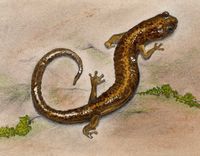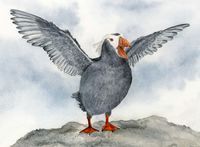
Koala
Latin name: Phascolarctos Cinereus,Conservsation status: vulnerable (population is decreasing)
The Koala is not a bear, but a marsupial. Like the kangaroo, it carries its young in a pouch. It rarely drinks water—Koala means "no water" in native Australian. Its water and food come from eucalyptus leaves, which are water rich but nutrient poor. To conserve energy, the Koala naps up to 20 hours a day and stays up in its home trees most of the time.
Koalas live in the woodlands of Australia. Thick fur and skin make it difficult for them to adapt to rising temperatures. Increased CO2 in the air produces less protein in the eucalyptus leaves, forcing the Koala to search for other sources of food and, in times of high heat, water. On the ground, the slow moving Koalas are prey to wild dingoes and domestic dogs, or are hit by cars as they cross roads. Their habitats are also being destroyed by drought, bush fires and development.
Other animals effected by climate change
 Shenandoah Salamander
Shenandoah SalamanderThe Shenandoah Salamander lives in an isolated, high altitude region of Shenandoah National Park, USA. Like all amphibians who have thin, permeable skin, salamanders are very sensitive to environmental changes. If average temperatures or moisture increase, this salamander, restricted to its cool micro-climate, will be at risk—having no place to go but to lower, even warmer, altitudes. If warming causes other species of lower altitude salamanders to migrate higher, they will compete for the Shenandoah's cool, moist habitats.
 Polar Bear
Polar BearPolar Bears live only in the Arctic. Loss of sea ice has a critically adverse effect on Polar Bears. They hunt from the edge and build snow dens on the ice for resting and raising their cubs. Sea ice decline could open the Arctic to shipping and tourism, further disturbing Arctic habitats. Other threats are oil development and industrial pollution that reaches the Arctic through air and ocean currents.
 Tufted Puffin
Tufted PuffinTufted Puffins are threatened by sea level rise and storm surges which destroy habitats and breeding areas. In some areas of North America warming seas are causing the fish that the Puffins feed on to migrate farther north, making it difficult for them to find adequate food. Other threats are entrapment in fishing nets, oil spills, pollution, ingestion of plastic, human disturbance of breeding colonies and introduced predators such as rats and foxes.
 Beluga
BelugaBelugas live in Arctic and Sub-Arctic waters. Impacts from climate change include: an increase in ship traffic as sea ice declines, oil exploration and extraction, fisheries by-catch, and disruption of the food web. As Arctic waters warm and currents change, the Humpback (a competitor) and the Orca (a predator) may move north and stay longer. Some Beluga populations are also threatened by hunting, pollution and habitat loss.
